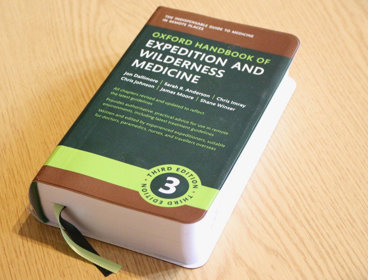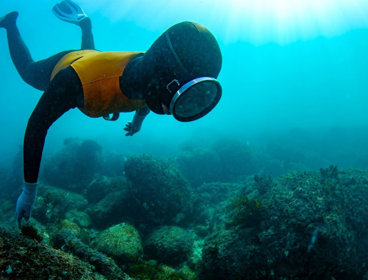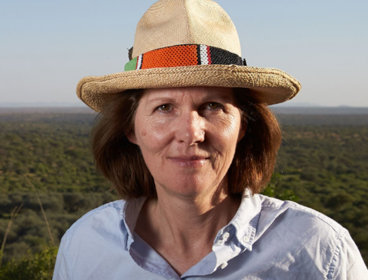Expedition safety is an essential part of planning any new venture. Managing risk effectively in the field is something that should never be overlooked.
Whether you’re conducting an individual expedition or are part of a larger team, understanding the level of risk associated with the project, what you need to do to keep yourself and your colleagues safe, and what you might need to do in the case of an emergency is everyone’s responsibility.
With almost 200 years of support for expeditions, the Royal Geographical Society has a well-established history of ensuring that expeditions are conducted in a safe and responsible manner. The Society promotes good practice in field safety management and, along with other organisations, sets national and international standards for field safety.
Additionally, the Society provides education and training with the aim of reducing the risk of death or serious injury of those participating in expeditions; for example, through the delivery of our own Off-Site Safety Management courses.
Understanding the risks
Expeditions often include inherent risks and challenges. It is the responsibility of the organisers and all involved to attempt to avoid serious injury or death by building a competent team and mitigating significant risks.
All participants need to understand the risks involved before agreeing to take part in a project.
Preparing a Risk Assessment (RA) and sharing it with the team at an early stage, when establishing the project’s aim and supporting objectives, will avoid significant disagreements about the acceptable level of risk involved in a project later or while in the field.
What is a Risk Assessment (RA)?
A Risk Assessment, often abbreviated to 'RA', is a document that provides an overview of your proposed expedition and identifies the significant associated risks. Once those risks have been evaluated, the document will provide a summary of what precautions need to be taken to mitigate these risks and then reflect how potentially hazardous the chosen activities remain.
When you compile the Risk Assessment, make sure the risks identified are specific to your project. Start with generic risks, using past assessments or expedition reports for reference, then apply these to your expedition.
Generic:
| Hazard | Risk | Control Measure |
|---|---|---|
| Road traffic collision | Injury or death | Use a recommended taxi firm. Ensure seat belts are worn at all times. |
Specific:
| Hazard | Risk | Control Measure |
|---|---|---|
| Road traffic collision | Injury or death | We will use ACME taxis, a recommended taxi firm. The road from the airport to town is a known accident black spot; we will ensure arrival at airport for mid-morning to ensure the journey is done in daytime and outside of rush-hour. |
If you are travelling overseas from the UK, a good starting point is the FCDO’s Travel Advice for advice and warnings about travel abroad, including entry requirements, safety and security, health risks and legal differences. You can sign up for email updates by country or territory. If you travel to areas where the FCDO "advises against all travel", your insurance is likely to be invalidated.
If you deem your expedition to be putting people at unnecessary risk, then ultimately it should not be one that goes ahead in its current form and will need re-evaluating.
The risk assessment process is only effective if all members of the expedition understand the necessity to adhere to the control (mitigation) measures outlined in the Risk Assessment, and are willing to behave accordingly.
What should be included in a Risk Assessment?
- The competence of the team (leaders and participants)
- Environmental hazards
- The activities: e.g. glacier survey, cave exploration
- Transport and accommodation
- Political and cultural threats
- Pre-existing medical conditions and travel health
What is incident and emergency response planning?
Risk Assessments do not guarantee the absence of incidents and accidents. Accidents do happen, and participants must be prepared for that eventually through Incident and Emergency Response planning. All members of the team should be aware of the capacity of the expedition to affect an emergency response when they consent to participate.
Imagine that something has gone wrong. Someone is injured, conditions have changed, the situation has become untenable. What do you do? Your Emergency Response Plan will ensure you have procedures in place, so you all know what steps to take to prevent the situation from escalating.
Changing circumstances are intrinsic to expeditions, so planning how to manage both minor and major incidents, including allocating the roles and responsibilities of the people who will be responsible for actioning these, is essential.
The Risk Assessment process should identify the complexity of the incident and emergency response plans needed. A good way to start is with the question “What if x, y, z happens? What would we do?”. This is sometimes also called 'contingency planning'.
These responses are likely to involve a workable communications plan, access to finance, support from external agencies, and access to medical services. Contact details for medical and support services, such as your insurance provider(s), should be documented and shared with the relevant individuals who may be required to enact the plan. Different responses may be needed for incidents during the day and at nighttime.
Potential incidents to consider for your contingency planning
Among the incidents (unplanned occurrences) and emergencies (requiring immediate action), with the potential to cause harm or a significant change of plan that you should consider and discuss what actions should be taken, you might include:
- Any member of the team is insufficiently competent to undertake their duties, or is unable to continue through illness or injury
- A changing security situation
- Extreme weather events
- Transport delays, breakdowns or identified as unacceptable
- Theft or loss of money or the need for additional funds.
- Damage or loss of critical equipment or clothing
- Significant change of route or unplanned activities
What to include an Emergency Response Plan (ERP)
An Emergency Response Plan should include as a minimum:
- Roles and responsibilities in an emergency
- Initial Response steps
- Emergency Services contact numbers
- Medical Facility information
- Itinerary and evacuation options
- Emergency contact list for participants and their Next of Kin.
- Diplomatic missions (e.g. embassy or consuls) for all nationalities in the team;
- Airlines (national and international) and/or other transport providers;
- Emergency medical repatriation services and insurance companies;
Other considerations to include:
- Actions for the specific medical needs of any participant (pre-existing medical conditions identified during the Risk Assessment process)
- Missing person procedures
- Media management following an incident
Accidents and emergencies, even when successfully resolved, can be stressful for all concerned. Procedures for monitoring participants post-incident, and any follow-up support or counselling should be considered.
Medical insurance
Adequate and appropriate medical, evacuation and repatriation insurance should be in place for all participants. This is an essential part of pre-expedition planning and is integral to the Emergency Response Plan.
Medical insurance should include:
- Emergency assistance and repatriation, including, where possible, air ambulance and air transport costs
- Emergency dental treatment
- Travel and accommodation expenses for a minimum of one person who needs to travel with or escort an incapacitated participant
It can be difficult for small private expeditions to obtain group medical insurance policies, so seek advice from a professional insurance broker. Where individuals have taken out their own medical insurance, include everyone’s insurance details in the Emergency Response Plan.
Any pre-existing medical conditions must be disclosed to the insurer. Insurers may refuse insurance on the grounds of pre-existing medical conditions or require a higher premium.
What is an emergency communications plan?
A robust emergency communications plan is vital to ensure your team can contact the outside world should something go wrong.
This should include key organisations and individuals who are aware of your plans and have been briefed how to respond in an emergency. This is likely to include contacts in the country where team members are normally resident (often called the 'home agent') and in the country where the expedition is operating ('in-country agent/agencies').
Before going into the field, draw up policies and procedures for communication in the event of an emergency, and a back-up plan should the preferred method fail. Ensure that all potential users of communications procedures, systems and resources are trained in their use.
Communication devices come in many forms. Telephones – landline, mobile or satellite – have the advantage of familiarity of use and with increasing global coverage are likely to be the first choice for many expeditions. Modern mobile phones with local SIM cards may be all that you need, but it is important to check that your phone will work in country and your chosen location has reliable coverage. A satellite phone is a useful and accessible piece of kit that can be hired but there may be local restrictions on their use. In some jurisdictions, possession of a satellite phone can result in imprisonment.
Two-way communication is important as you can have a dialogue with potential extraction team or medical advisors. A simple location beacon may not be enough.
Other two-way communication devices from which you can send and receive text messages and emails but without the voice calls, such as the Garmin InReach, are used by many expeditions when out in the field. They also provide remote satellite tracking and can be paired with a smartphone.
Managing safety in the field
Once you arrive in the field, all your pre-expedition planning should be rewarded with a clear action plan of what everyone needs to do to keep themselves and others safe from harm or serious injury.
Your Risk Assessment should have identified what checks need to be undertaken when you arrive. For example, have the vehicles you are using got the seat belts that you were expecting? If not, your contingency planning should have considered what alternatives are likely to be open to the group if this happens. Vehicle and accommodation safety checklists can be helpful identifying your pre-booking requirements to potential third-party providers, and then to make sure that these the agreed requirements have been met when you arrive. Written evidence is important if you need to resolve any disputes over safety issues.
Briefings, at the start and end of each day, can be useful to identify any key safety management issues that need to be uppermost in people’s minds for the day ahead, and any changes that might need to be made due to poor weather or personnel who are unwell. They are also an opportunity to update everyone on any changes in plan. These don’t need to be long and boring. Giving others an opportunity to lead these briefings will add variety and different perspectives. You may want to run some training sessions in the field to refresh or improve skills such as first aid, navigation, river-crossings, and emergency response.
The level of supervision needed and how team member activities will be monitored and managed in the field should also have been discussed as part of your risk assessment and safety management plan. Groups involving young or inexperienced members are likely to need close supervision. Remote supervision of lone workers, if lone working is allowed, needs to be subject to clear communications protocols.
Behaviour codes agreed by all participants can provide clarity around rules such as the consumption of alcohol, taking part in recreational activities beyond those of the expedition, and the sanctions if someone’s behaviour is deemed unacceptable.
Are you an educator or teacher researching field visits?
If you are acting in a supervisory capacity on an expedition involving young and/or vulnerable people, additional considerations will apply regarding duty of care and the legal framework surrounding such ventures.
The main source of guidance for school visits is published by the Outdoor Education Advisers’ Panel (OEAP) to help you organise high quality outdoor learning, adventurous activities and educational visits including residential and overseas visits.
For visits taking place within a school context, Educational Visits Coordinator (EVC) training courses are available for existing and new staff members nominated for this role, with the course accredited by the Outdoor Education Advisers’ Panel (OEAP). We also publish health and safety resources as part of our support for fieldwork in schools.
Working in a UK Higher Education Institution?
Higher education sector guidance on health and safety in fieldwork and travel for both UK and overseas is published by the UK Universities Safety and Health Association (USHA).
The Society also publishes resources to support good practice in health and safety management on undergraduate fieldwork courses.
In summary: come back alive!
Ultimately, the success and integrity of any expedition hinge upon a steadfast commitment to safety. From meticulous Risk Assessments and comprehensive Emergency Response Plans to robust communication strategies and adequate medical insurance, every element plays a role in safeguarding lives and achieving objectives responsibly. The Society, alongside other dedicated organisations, has championed this ethos for decades, fostering a culture where adventure and exploration are pursued with the utmost care.
As you embark on your next venture, remember that true success isn't just about reaching your goal, but about the safe return of every individual. By prioritising safety, you're not just protecting your team; you're empowering them to push boundaries and achieve the extraordinary, confidently and securely.
Stay updated
Be the first to hear when new resources are launched by subscribing to our monthly exploration community newsletter. You'll also receive relevant news and events from the Society.
- You will be asked to create a free Society account if you haven't already done so.
- Once logged in, navigate to My preferences and select News and events about fieldwork and expeditions.





